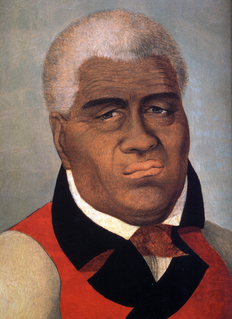Related Research Articles

Kamehameha I, also known as Kamehameha the Great, was the founder and first ruler of the Kingdom of Hawaii. A statue of him was given to the National Statuary Hall Collection in Washington, D.C. by the state of Hawaii as one of two statues it is entitled to give.

Kuini Liliha was a High Chiefess (aliʻi) and noblewoman who served the Kingdom of Hawaii as royal governor of Oʻahu island. She administered the island from 1829 to 1831 following the death of her husband Boki.

Kalanikauikaʻalaneo Kai Keōpūolani-Ahu-i-Kekai-Makuahine-a-Kama-Kalani-Kau-i-Kealaneo (1778–1823) was a queen consort of Hawaiʻi and the highest ranking wife of King Kamehameha I.

The Battle of Kepaniwai was fought in 1790 between Hawaiʻi Island and Maui. The forces of Hawaiʻi were led by Kamehameha I, while the forces of Maui were led by Kalanikūpule. It is known as one of the most bitter battles fought in Hawaiian history.

Kameʻeiamoku was a Hawaiian high chief and the Counselor of State to King Kamehameha I. He was called Kamehameha's uncle, but he was really the cousin of Kamehameha's mother, Kekuiapoiwa II.
The House of Keōua Nui(Hale O Keōua Nui), or simply House of Keōua, is the extended royal family of Ancient Hawaii from which the reigning family of Kamehameha I and Lunalilo were descended.
Kalanikauleleiaiwi was a Chiefess on the island of Hawaiʻi in the late 17th century and early 18th century. She was considered to be the co-ruler of the island of Hawaiʻi with her half-brother, Keaweʻīkekahialiʻiokamoku, the 21st King of Hawaii. Their shared mother was Keakealaniwahine, the ruling Queen of Hawaii. Their son, Keʻeaumoku Nui, was considered the highest rank of Piʻo and the rightful successor in rank to his father and mother.
Kekuʻiapoiwa II was a Hawaiian chiefess and the mother of the king Kamehameha I.

Ulumāheihei Hoapili was a member of the nobility during the formation of the Kingdom of Hawaii. He was a trusted military and political advisor to King Kamehameha I, known as "Kamehameha the Great". Although trusted with one of the last symbolic rites of the Hawaiian religion, he later became a supporter of Christian missionaries.

Kahakuhaʻakoi Wahinepio was a Hawaiian chiefess and member of the royal family during the Kingdom of Hawaiʻi. Wahinepio means captive women in Hawaiian. Sometimes she is called Wahineopiʻo, or an extra ʻokina is added, calling her Kahakuhaʻakoʻi. She was also called Kamoʻonohu. She was considered Kamehameha I's third favorite wife and served as female Governor of Maui, an act unheard of at the time in the western world, but common in Hawaiian history.

Likelike was a high chiefess and member of the royal family of the Kingdom of Hawaii. Before the standardization of the Hawaiian language, her name was sometime written as Rikériki. She was the favorite wife of Prime Minister Kalanimoku, a powerful chief and statesman during the early years of the Hawaiian monarchy, and she would accompany him on his interactions with visiting Western explorers and American missionaries to Hawaii. Likelike and her newborn son Lanihau died shortly after the baby’s birth due to the shock caused by cannons fired to celebrate the royal birth. Her funeral was conducted under traditional Hawaiian customs with the exception of a Christian sermon, which was the first performed on a Hawaiian royal.
Keku‘iapoiwa I was a chiefess of the island of Hawaiʻi and Maui. She was also known as Keku‘iapoiwa Nui . Her full name was Keku‘iapoiwa-nui Kalani-kauhihiwakama Wanakapu.
Kekuʻiapoiwa Liliha was a queen of the island of Hawaiʻi.

Manono II was a Hawaiian chiefess and member of the royal family during the Kingdom of Hawaii. She along with her second husband Keaoua Kekuaokalani died fighting for the Hawaiian religion after Kamehameha II abolished the kapu system.

Peleuli, formally Peleuli-i-Kekela-o-kalani, was a Queen consort of the Kingdom of Hawaii as a wife of king Kamehameha I.
Alapaʻi was a king of Hawaiʻi island in ancient Hawaii. He was an usurper to the throne, but was considered a good ruler, one who loved the common people, although there is a story that he was responsible for the death of High Chief Keōua Nui. His title in Hawaiian was Aliʻi Aimoku.
Julia Alapaʻi Kauwaʻa was a high chiefess of the Kingdom of Hawaii. Her name has been given as Julia Alapaʻi Kauwa and sometimes as Juliana instead.
Koahou was a Hawaiian high chief who succeeded his father Kamanawa as one of the chief counselors of Kamehameha I.
Kānekapōlei was a Native Hawaiian aliʻi wahine (queen) and wife of Kalaniʻōpuʻu, aliʻi nui of the Island of Hawaii and aunt of Kamehameha I, who were all present at Captain James Cook's death. She called attention to the kidnapping of her husband by Cook and his men, attracting his royal attendants to the beach, answering her calls for help.
Haʻaheo Kaniu or Kaniuʻopiohaʻaheo was a high chieftess (aliʻi) and member of the royal family of the Hawaiian Kingdom. She was also known as Lydia Haʻaheo Kaniu.
References
- ↑ King et al. 1784, p. 155.
- ↑ Kamakau 1992, p. 118.
- 1 2 Mookini 1998, pp. 5–7.
- 1 2 Fornander 1880, pp. 212–213.
- ↑ Kamakau 1992, pp. 79, 118, 215.
- ↑ Kamakau 1992, p. 260.
- ↑ Kamakau 1992, p. 145.
- ↑ Fornander 1880, pp. 232.